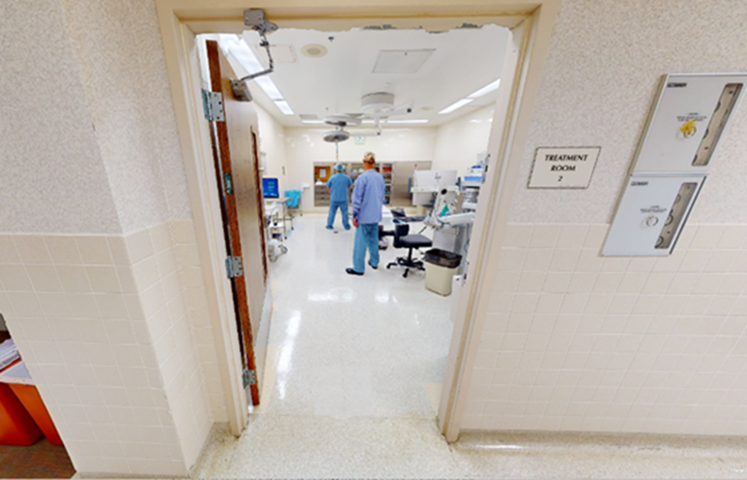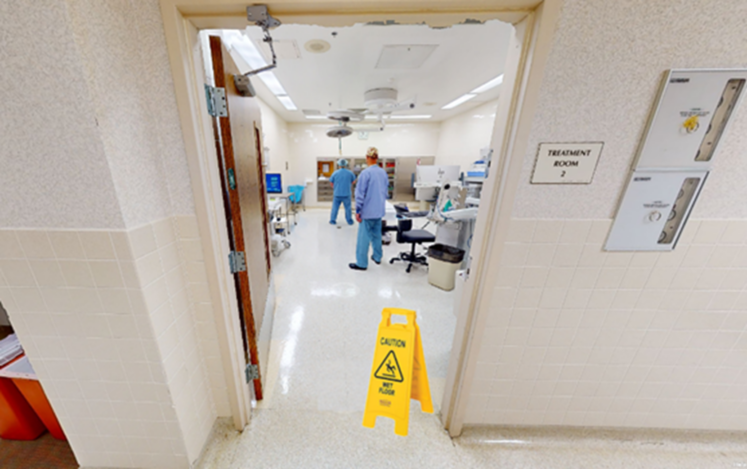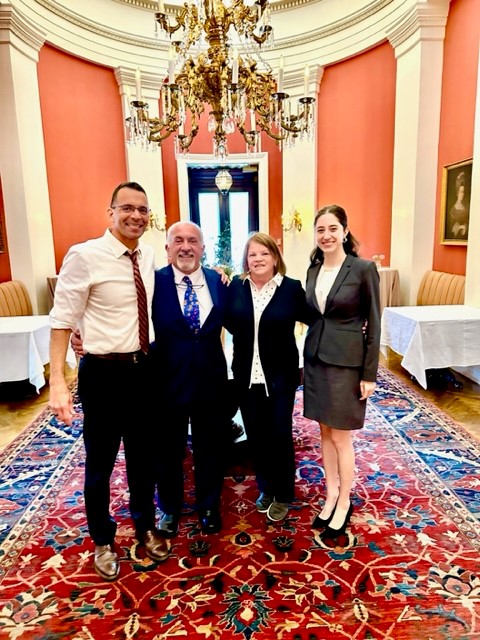In a recent legal battle, attorneys Brendan Lupetin and Maggie Cooney of Lupetin & Unatin, LLC, achieved a remarkable victory for their client, Dr. Alonge, a Navy veteran and dedicated oral surgeon. Facing an unfair offer of $150,000 to settle a slip and fall lawsuit, they managed to secure a staggering $3.2 million jury verdict in Erie County, Pennsylvania. How did they accomplish this incredible feat? Let’s dive into the story.
A Life Devoted to Healing
Dr. Alonge was not just any surgeon; he was a compassionate healer who had dedicated his life to oral surgery. With decades of experience, he treated thousands of patients in Erie County. Beyond his private practice, he volunteered his time at the Cleft Palate Institute, helping children born with craniofacial anomalies. He was a loving family man with a wonderful wife, Karen, and two beloved adult children.
The Surgery Center’s Negligence
For more than twenty years, Dr. Alonge’s regular routine involved performing surgeries at the St. Vincent Surgery Center. This facility offered operating rooms to Erie surgeons in exchange for payment. However, there was a dangerous practice at play – the Surgery Center’s custodians were trained not to place wet floor signs during mopping but only afterward. This policy posed a significant risk to anyone entering the operating rooms.
Uncovering the Truth
During the legal process, Lupetin & Unatin had to dig deep to uncover crucial information. Initially, the Surgery Center claimed that there had been no previous slip and falls like Dr. Alonge’s. However, during depositions, a nurse anesthetist admitted to having experienced a similar fall herself two years before. The Surgery Center had even created an incident report about that incident but had kept it heavily redacted.
A Courtroom Victory for Transparency
When the Surgery Center refused to provide an unredacted copy of the incident report, the Lupetin & Unatin legal team had to seek intervention from the trial judge. Ultimately, they succeeded in obtaining the complete report, which revealed that the Surgery Center had recognized the deficiency in their mopping policy two years before Dr. Alonge’s fall. The Surgery Center’s incident report acknowledged the need to place wet floor signs before mopping began, but this crucial change had never been effectively communicated to the custodians.
The Fateful Day
Fast forward to July 22, 2020, when Dr. Alonge found himself in the Surgery Center after completing his second oral surgery of the day. Unbeknownst to him, the operating room floor had just been wet mopped. Because there was no wet floor sign, Dr. Alonge walked into the operating room believing the it safe to do so. Dr. Alonge took a few steps and suddenly slipped, unable to catch himself in time, and fell hard onto the floor. He suffered injuries to his lower back and right rotator cuff, setting off a chain of events that would change his life forever.
The Devastating Consequences
Dr. Alonge’s injuries forced him to seek immediate medical care, hoping the pain would subside. However, the pain only worsened over time, eventually leading to a significant lumbar fusion surgery and a shoulder decompression procedure. His medical career was abruptly cut short, causing not only physical pain but immense emotional turmoil. Dr. Alonge’s plans to work for several more years were dashed. An economic analysis conducted by a forensic accountant concluded that the slip and fall caused Dr. Alonge to lose $1.4 – $1.5 million in income.
Robbed of his passion and identity as a surgeon, Dr. Alonge proposed to settle the lawsuit. But the Surgery Center thought little of his claims and offered only $150,000.
Battle Lines Drawn – We Head to Trial by Jury
When a fair settlement is impossible, trial by jury is the only option. Despite its clear negligence, the Surgery Center clung to numerous defenses.
Maintenance Man Mystery
First, the Surgery Center blamed Dr. Alonge and claimed he must not have been paying attention. They claimed the custodian was still in the operating room, actively mopping the floor at the time of the fall. The Surgery Center’s lawyers argued that Dr. Alonge should have recognized that active mopping was occurring and either stayed out of the room or walked more carefully. In fact, there was conflicting testimony regarding whether the custodian was in the room at the time of the fall. But more importantly, we were able to show this defense was irrelevant because the custodian had not placed a wet floor sign. We explained to the jury that Dr. Alonge was a detail oriented, borderline obsessive compulsive, surgeon who paid close attention to his surroundings. The juror’s common sense helped them realize that had a wet floor sign been placed, Dr. Alonge is precisely the type of person who would have recognized it and responded accordingly.
A 3-Dimensional Defense
But the surgery center felt so strongly about this argument they hired a company to take 3-D photos of the operating room. Here is a still from one of those photos which the Surgery Center attempted to use to blame Dr. Alonge for not recognizing and reacting to the custodian.

To easily counter this argument, we showed what the situation should have looked like by superimposing a wet floor sign into the photo.

Cell Phone Shenanigans
The hospital pointed to the fact that Dr. Alonge testified that at the time of his fall he had his cell phone in his hand to imply he was distracted by texting or talking. But we were able to explain that Dr. Alonge’s phone was in locked mode and that he only had the phone to call patients’ families between procedures who could not be in the hospital due to COVID precautions.
Surgical Booties to Blame?
Another liability defense raised by the Surgery Center was that Dr. Alonge contributed to his fall by wearing surgical booties over his shoes as the booties decreased his traction. This was an easy defense to refute because the booties were provided to Dr. Alonge by the Surgery Center. And the booties were used by Dr. Alonge to maintain sterility. So if anyone were to “blame” for the booties, it was the Surgery Center.
Big Picture Problems
Separate from the Surgery Center’s liability defenses we had concerns about a jury’s willingness to award substantial money damages to a surgeon who was already financially well off. The defense played to this potential bias throughout trial by asking irrelevant questions about our client’s wealth and vacations to Hawaii. We countered by having Dr. Alonge explain how from humble beginnings he pulled himself up by the bootstraps with hard work. Ultimately, the jury only cared about the facts and evidence and were unmoved by any wealth bias.
Trial Theme & Case Frame
Our trial theme was “When a healthcare corporation CREATES a hazardous condition and knows of its danger, it must do something to protect people from getting hurt.” To support our theme we focused on the fact the Surgery Center knew wet floors were dangerous, it knew its wet mopping policy dangerous, and that it knew it needed to change the policy to protect people like Dr. Alonge. Our case frame, which we were less overt about was a system failure due to a failure to communicate.
Order of Evidence
Our order of proof was designed to prove our case with the defense witnesses. Our first witness was Debbie Desser the head nurse of the Surgery Center and the author of the incident report. Through her we proved the defendant’s awareness of the danger of the mopping policy and that they had intended to correct the policy but failed to communicate the change to the people that matters, the custodians. We ended her exam by asking if she could do it all over again, would she do anything different. Her awkward 20 second pause before answering told the jury everything.
Next, we called the custodian. Maggie Cooney began this exam by making sure the custodian, “Mike S,” understood that we were not blaming him for what happened. His relief palpable, the rest of this exam was smooth sailing. Attorney Cooner had the custodian confirm that everyone knows that wet mopped floors are dangerous if not warned of. He also agreed that, he knew it was best practice to place a wet floor sign while mopping.
We learned from one of the jurors after the trial that we had all but won the trial by this point, at least from a liability perspective. When the jurors learned the truth of what occurred without any significant response from the Surgery Center, their minds were made up on fault.
To drive the point home, however, we next called a wonderful biomechanical engineer, Dr. Andrew Rentschler in our case in chief. Dr. Rentschler explained how falls occur, why wet floors are dangerous when you walk on them unknowingly, and how Dr. Alonge’s fall mechanics were consistent with the lower back and shoulder injuries he sustained. Dr. Rentschler has also evaluated hundreds of slip and fall cases for both plaintiffs and defendants. He is a true expert when it comes to assessing fault and the cause of a slip or trip and fall incident.
We called a couple of condition witnesses who knew our client and had worked with him. They confirmed how different, physically, Dr. Alonge was before and after the fall. They also explained what a wonderful person he is as well as his notorious attention to detail. This latter testimony helped us show that Dr. Alonge was a careful person, would only fell because the Surgery Center negligently chose not to place a wet floor sign during wet mopping.
We next called Karen Alonge, Dr. Alonge’s wife, who talked about his passion for being a doctor. She focused mostly on the impact his early retirement had on him, because we all agreed this was the biggest form of damages in the category of “loss of the pleasures of life.”
Dr. Alonge was our penultimate witness who described his backstory of how he became an oral surgeon. We did not have Dr. Alonge talk much about his personal injuries as we find the injured party’s testimony about damages often falls flat with juries. Instead, we focused on his attention to detail, love of medicine, and plans to work for at least another three years but for the fall.
Lastly, we called out economist, Jim Fellin, who simply and matter-of-factly explained the economic losses that totaled $1.4 million. We made a strategic decision to drop a portion of the economic loss claim accounting for loss of household services. This is the value of the person’s work contribution to their household. However, through hard work and a lot of medical treatment, Dr. Alonge had made great physical strides by the time of trial such that we felt a claim that he couldn’t physically contribute around the home was unnecessary.
As a general practice, we respect juror’s time and move as quickly as we can through our evidence. This case was no different. We rested our case after only one and a half days, including opening statements.
An Uphill Battle for the Defense
The defense lawyers were left with a tall order to overcome the compelling story we had told. They began by calling their own engineering expert. But unlike Dr. Rentschler, their expert was a structural engineer whose work focuses on tensile strengths and whether bridges and buildings can withstand various stresses and pressures. While interesting, his background was irrelevant to a slip and fall. This expert admitted he had only evaluated three fall cases ever. Curiously, he admitted that he was not asked by his lawyers to consider the relevance of the lack of a wet floor sign. Instead, he had been retained to test the slipperiness of the operating room where Dr. Alonge fell. In a “Captain Obvious” moment, the defense expert told us that when water is on the floor, it is more slippery than when there is no water on it. To say the jury was unmoved by the testimony is an understatement.
The last two witnesses called by the defense were pseudo-eyewitnesses to the fall. Both witnesses were nurses who were in the room when Dr. Alonge fell. However, both had different recollections of when, where, and how Dr. Alonge fell. They also disagreed on who else was in the room at the time. But they both agreed he slipped and fell in the same area Dr. Alonge fell. Thus this testimony did not move the needle much for the defense.
During litigation, Dr. Alonge had been sent for “independent” medical exams by other lawyers. However, all these doctors agreed that Dr. Alonge was hurt due to the fall. All of the “independent” doctors also agreed that while Dr. Alonge made a terrific recovery from his injuries and surgeries, he could not return to work as an oral surgeon. Because of this, the Surgery Center’s lawyers made the understandable decision not to call any opposing medical experts.
Similarly, the defense lawyers retained their own economist to assess Dr. Alonge’s financial losses but even he agreed that Dr. Alonge lost out on at least $1 million. Again, the defense lawyers made the correct decision not to offer their economist’s testimony.
The Close of the Case
After a short break, we proceeded to closing arguments. The defense lawyer attempted to shift blame away from the Surgery Center and on to Dr. Alonge. He pointed out that sometimes, “accidents just happen.” He also highlighted the fact that Dr. Alonge did not appear that hurt insinuating he did not deserve a substantial verdict.
We take an informative approach to closing argument. We use the verdict slip as the outline and guide to our arguments. We explain the important job the jurors have to do. We highlight the key portions of the jury instructions (i.e. the law) they will be asked to apply to the facts and evidence. And we go through step by step each of the questions on the verdict slip and explain how the evidence supports answers in our client’s favor. “Was the Surgery Center Negligent?” I will read to them. And then I will explain that we know they were negligent and the jury should check “yes” for all of these reasons. It is important to remind the jury of their agency and power to decide what they believe is right. Just like we rejected being force fed as small children, so to do most reasonable people resist being forced into a decision. The truth is that the jury is the community conscience. We provide them our best presentation for why we are right, why the facts, evidence, and truth stand in our favor and then we let them decide. We must resist the temptation that is based in fear to try and force our will on them. And that is what we did. We gave the jury the best argument, we gave them the power, and then we trusted them to do the right thing. And they did, with a quick verdict in Dr. Alonge’s favor.
Deliberation and Verdict
A short deliberation indicates that the jury had their mind made up as a majority before closing arguments. After approximately 40 minutes of deliberation, the jury submitted a question to the Court. The question was, “May we see the financial projections of Mr. Felling?” This was obviously a good sign as the jury quickly moved to a discussion of damages. A few minutes after that they had a verdict that found the Surgery Center 100% at fault and awarded Dr. Alonge damages as follows:
Past Economic Loss: $1,411,261
Future Economic Loss: $320,000
Past Non-Economic Loss: $750,000
Future Non-Economic Loss: $750,000
Total: $3,231,261
Key Strategies for Success
- A Credible Plaintiff: Dr. Alonge’s credibility played a crucial role in the success of the case. Jurors tend to harbor skepticism in slip and fall cases, so having a highly credible plaintiff was vital.
- Discovery of a Similar Incident: Discovering a previous similar incident helped establish that the Surgery Center was aware of the danger and could have prevented Dr. Alonge’s fall.
- Keeping the Case Simple and Short: Jurors often make up their minds early in the trial. A concise and straightforward presentation can be highly effective in conveying the facts.
 In the end, justice prevailed. The jury found the Surgery Center 100% at fault and awarded Dr. Alonge $3.2 million in damages. This case serves as a powerful reminder that when a healthcare corporation creates a hazardous condition and is aware of its danger, they must take responsibility to protect people from harm. While the legal battle was arduous, it was a testament to the power of persistence and the pursuit of justice.
In the end, justice prevailed. The jury found the Surgery Center 100% at fault and awarded Dr. Alonge $3.2 million in damages. This case serves as a powerful reminder that when a healthcare corporation creates a hazardous condition and is aware of its danger, they must take responsibility to protect people from harm. While the legal battle was arduous, it was a testament to the power of persistence and the pursuit of justice.
If you’ve been injured in a slip and fall or trip and fall incident, or if you’re an attorney working on a premises liability lawsuit, Lupetin & Unatin, LLC, is here to help. We believe in sharing our knowledge and experience to uplift the legal community because, as the saying goes, “a rising tide lifts all boats.”
